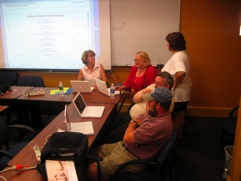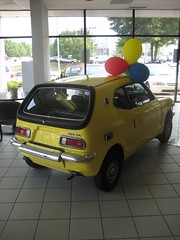 I had a very interesting conversation last night in the Inspiration Station, a room set asside for chatting at the MLTI Summer Institute — sort of a blogger’s cafe. But before I share that conversation, it’s important to have the context of the short keynote I’d delivered just before. In it, I suggested three converging elements of what we do, and how, through the shared electrons of those elements (if I might carry the metaphor a little further), we might generate the energy that we need to drive learning in flat classrooms, turning them into learning engines.
I had a very interesting conversation last night in the Inspiration Station, a room set asside for chatting at the MLTI Summer Institute — sort of a blogger’s cafe. But before I share that conversation, it’s important to have the context of the short keynote I’d delivered just before. In it, I suggested three converging elements of what we do, and how, through the shared electrons of those elements (if I might carry the metaphor a little further), we might generate the energy that we need to drive learning in flat classrooms, turning them into learning engines.
Those elements are:
- We are preparing children for a future we can not describe
- We are preparing children, who as a generation, are enjoying a rich information experience outside-the-classroom.
- We are preparing children within a new and dynamic information environment with new qualities that seem ready made for teaching and learning.
As I walked up behind Ernie Easter and Michael Cushman, they were working with some video using iMovie. As a matter of full disclosure, the only reason that I remember their names is that I took pictures of their name tags. Michael (or Ernie) looked back and asked, “Do you know what this is?”
I shrugged and then he answered, “8 millimeter film.”
“OK, that’s cool.” Then I may of shrugged again.
They commenced then to describe New Sweden, a town or small region of Maine that was settled by immigrants from that country, where they remained fairly isolated for generations, continuing to speak their own language and practice their own culture. Michael and Ernie have collected old 8mm films that have been taken in that region, recording their practices, celebrations, and everyday life. They are employing their students to interview their relatives and other members of their community and to help in archiving the film, organizing it, and make it available online. Much of it will be available through the Maine Memories project.
I asked how the video clips will be tagged, and one of the young men said that they are using Library of Congress methods, but the other guy Michael or Ernie, interrupted and said, “He’s asking about Web 2.0, and he’s right. We could get the kids to tag the clips.”
It was about that time that something started bothering me. This is a good thing, because it means that there may be something important going on that my A.D.D. contaminated brain simply can’t pull together into a singular concept. But then it occurred to me that there was a real disconnect going on here — and so often disconnects lead to profound connections.
I’d just gotten through talking about the challenge and opportunities of preparing children for a future we can not describe. And here are kids who are engaged in learning about their past. I asked, “What are your students learning in this process?”
After a pause, “They’re learning to research, to think, to work with media, to organize, to draw conclusions..”
“And all of this combines to do what?”
“They are learning!”
“They’re learning by teaching themselves. And isn’t that the best thing we could be doing to make them ready for an unpredictable future — to teach themselves?”





 It makes no difference — shade or out in the sun, it’s just plain hot in Raleigh today. I road my bike this morning, but no walk this afternoon!
It makes no difference — shade or out in the sun, it’s just plain hot in Raleigh today. I road my bike this morning, but no walk this afternoon! Guest4223 (most chatters kept the random guest id assigned by AjaxChat) described
Guest4223 (most chatters kept the random guest id assigned by AjaxChat) described  guest_9999 • 2007-08-07 13:00:59\\
guest_9999 • 2007-08-07 13:00:59\\
 We, edubloggers, do not see blogging as our profession, but merely another avenue for communicating — something that is almost exclusively our job. I guess what resonated with me, when I read through this article, is the growing access that we all have to opportunities for expressing ourselves, and even opportunities to generate income in the process. It isn’t just writing, but photography, art, video, music, animation, etc. Self-expression as a lifestyle, or even as a line of work, no longer depends on geography, who you know, or even being the most talented at your craft.
We, edubloggers, do not see blogging as our profession, but merely another avenue for communicating — something that is almost exclusively our job. I guess what resonated with me, when I read through this article, is the growing access that we all have to opportunities for expressing ourselves, and even opportunities to generate income in the process. It isn’t just writing, but photography, art, video, music, animation, etc. Self-expression as a lifestyle, or even as a line of work, no longer depends on geography, who you know, or even being the most talented at your craft.  George Bush’s Jan 2007 State of the Union Address. You’ll find a scroll tool at the far right of the bar. Grab it and drag it back to the left to scan through other addresses, going back to “Foundation of Government,” Jan 15, 1776, by John Adams.
George Bush’s Jan 2007 State of the Union Address. You’ll find a scroll tool at the far right of the bar. Grab it and drag it back to the left to scan through other addresses, going back to “Foundation of Government,” Jan 15, 1776, by John Adams.
 Then the other fellow walked me over to his computer, a MacBook Pro, and proceeded to take me on a tour of Leopard, Apples new OS software. Some of you are, no doubt, aware that Leopard is not even out yet. But this sixteen year old kid is taking me on a tour, because
Then the other fellow walked me over to his computer, a MacBook Pro, and proceeded to take me on a tour of Leopard, Apples new OS software. Some of you are, no doubt, aware that Leopard is not even out yet. But this sixteen year old kid is taking me on a tour, because 
 I had a very interesting conversation last night in the Inspiration Station, a room set asside for chatting at the MLTI Summer Institute — sort of a blogger’s cafe. But before I share that conversation, it’s important to have the context of the short keynote I’d delivered just before. In it, I suggested three converging elements of what we do, and how, through the shared electrons of those elements (if I might carry the metaphor a little further), we might generate the energy that we need to drive learning in flat classrooms, turning them into learning engines.
I had a very interesting conversation last night in the Inspiration Station, a room set asside for chatting at the MLTI Summer Institute — sort of a blogger’s cafe. But before I share that conversation, it’s important to have the context of the short keynote I’d delivered just before. In it, I suggested three converging elements of what we do, and how, through the shared electrons of those elements (if I might carry the metaphor a little further), we might generate the energy that we need to drive learning in flat classrooms, turning them into learning engines.  I’m back on the grid now, more or less, sitting in the Maine maritime Academy in Castine, Maine — a beautiful little town next tome some beautiful water, dotted with beautiful sail boats, some made of fiberglass and some made of polished wood.
I’m back on the grid now, more or less, sitting in the Maine maritime Academy in Castine, Maine — a beautiful little town next tome some beautiful water, dotted with beautiful sail boats, some made of fiberglass and some made of polished wood.